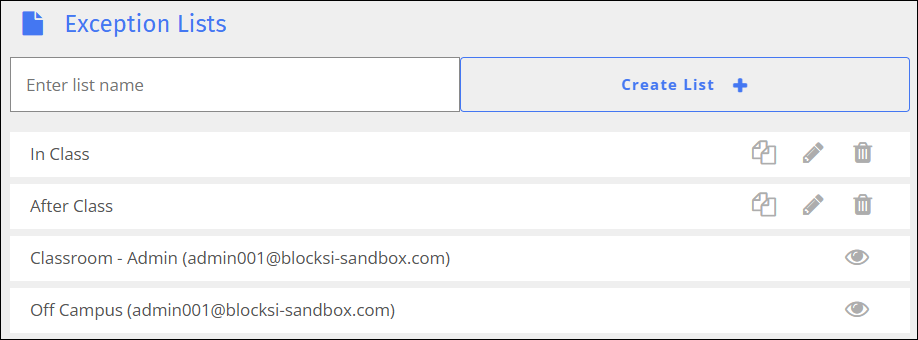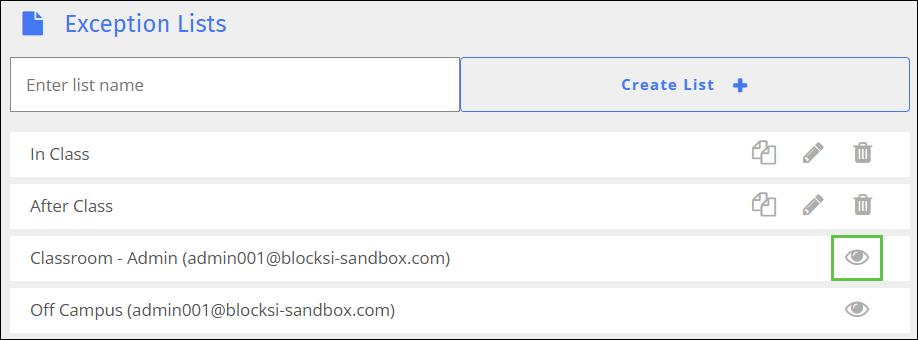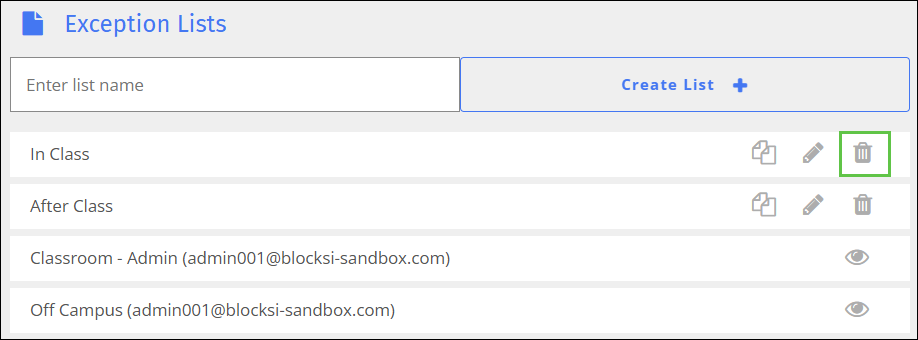Block and allow access to sites and specific URLs by adding them to an exception list. Using patterns containing text and wildcards, block and allow entire domains, subdomains, and parts of a domain. For example, msn.com, *.msn.com, msn.*, and *msn*.
Adding msn.com as an exception blocks or allows access to the entire msn.com website.
To allow Google searches, while blocking Google subdomains, do the following:
Allow google.com on your exception list.
Block *.google.com on your exception list.
This allows users to access google.com, but blocks them from accessing any Google sub-domains, such as mail.google.com and chat.google.com.
To block search results and URLs containing the keyword horror, block horror on your exception list. This blocks the following:
Web addresses like sites.google.com/site/horrorgames and horrorvideos.com
Search results for horror
There are many ways to use wildcards to filter content. Blocksi suggests that you experiment with different variations.
Create as many exception lists as you need.
To create an exception list
Click Filters from the Main Menu and then click Exception Lists from its sub-menu. The Exception Lists screen appears.

Type the name of the list in the Enter list name text box.
Click Create List + to add the list. The list appears at the bottom of the list.
Click the
 icon. The Edit screen appears. See Blocking and Allowing URLs for details on blocking and allowing URLs.
icon. The Edit screen appears. See Blocking and Allowing URLs for details on blocking and allowing URLs.Note
The exception lists with the
 icon were shared with you by your administrator and cannot be edited.
icon were shared with you by your administrator and cannot be edited.
You can view exception lists assigned to you by your administrator on your Exception List screen, but you cannot edit them.
To view an administrator-assigned exception list
Click Filters from the Main Menu and then click Exception Lists from its sub-menu. The Exception Lists screen appears.

Locate the list to view and click the
 icon. The list appears, but cannot be edited. Note that the entries are disabled.
icon. The list appears, but cannot be edited. Note that the entries are disabled.
Block and allow as many URLs as you need in an exception list.
To block and allow URLS in an exception list

Type a URL in the Enter URL text box.
Click the Block or Allow button.
Click Add to List +. The URL you entered appears after the examples. Note that the Allow button to the right of the URL name is selected (appears in blue).
Note
Click the Allow or Block button at any time to change a blocked URL to an allowed URL and vice versa. Click Update to block or allow the URL.
Note
Click the  icon to delete the URL from the list. A confirmation prompt appears. Click OK to delete the URL.
icon to delete the URL from the list. A confirmation prompt appears. Click OK to delete the URL.
Delete a URL from an exception list when you no longer need it.
To delete a URL from an exception list
Click Filters from the Main Menu and then click Exception Lists from its sub-menu. The Exception Lists screen appears.

Locate the list that contains the URL to delete and click the
 icon. The Edit screen appears.
icon. The Edit screen appears.
Click the
 icon to the right of the desired URL. A confirmation prompt appears.
icon to the right of the desired URL. A confirmation prompt appears.Click OK to delete the URL from the list.
Rename an exception list as needed.
To rename an exception list
Click Filters from the Main Menu and then click Exception Lists from its sub-menu. The Exception Lists screen appears.

Locate the list to rename, and click the list name. A box opens to allow you to rename the list. Note that Blocksi added Save and Cancel buttons to the right of the name, as shown below.

Rename the list , and click the Save button.
Modify an exception list as needed.
To modify an exception list
Click Filters from the Main Menu and then click Exception Lists from its sub-menu. The Exception Lists screen appears.

Locate the name of the list to modify, and click the
 icon to the right of the list name. The Edit screen appears.
icon to the right of the list name. The Edit screen appears.Make the necessary changes to the filter, and click Save Changes.
Use an existing exception list to create a new one.
To duplicate an exception list
Click Filters from the Main Menu and then click Exception Lists from its sub-menu. The Exception Lists screen appears.

Locate the list to duplicate, and click the
 icon. The Duplicate List window opens.
icon. The Duplicate List window opens.
Type the name of the new list in the text box.
Click OK to add the list. The duplicated list appears at the bottom of the list. It contains the same URLs as the original list.
Make any desired changes to the new filter and save it.
Delete exception lists when you no longer need them.
To delete an exception list
Click Filters from the Main Menu and then click Exception Lists from its sub-menu. The Exception Lists screen appears.

Locate the list to delete, and click the
 icon to the right of the list. A confirmation prompt appears.
icon to the right of the list. A confirmation prompt appears.Click OK to delete the list.